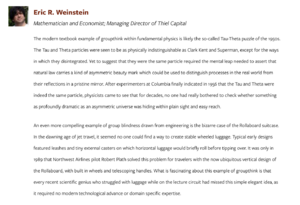Thaler's Question (Edge Event)
The flat earth and geocentric world are examples of wrong scientific beliefs that were held for long periods. Can you name your favorite example and for extra credit why it was believed to be true?
To selected Edge contributors:
I am doing research for a new book and would hope to elicit informed responses to the following question:
The flat earth and geocentric world are examples of wrong scientific beliefs that were held for long periods. Can you name your favorite example and for extra credit why it was believed to be true?
Please note that I am interested in things we once thought were true and took forever to unlearn. I am looking for wrong scientific beliefs that we've already learned were wrong, rather than those the respondent is predicting will be wrong which makes it different from the usualEdge prediction sort of question.
Several responders pointed out that the phrase "scientific belief" in my question was not well defined. Did I mean beliefs held by scientists or beliefs by the lay public about science. The answer is that I am interested in both, though I should stress that this is not at all what my next book will be about. I do not know enough about science to write anything about the subject. However, for the book I am thinking about stuff that we get wrong, often for long periods of time, and am doing some wondering about whether there are some principles defining when such mistakes are more likely to happen.
This exercise has been fantastically interesting, and if anyone is prompted by this to send in more ideas please do. I am also interested if anyone has thoughts about what the principles might be, if, indeed there are any.
— Richard Thaler on Edge.org
Eric's AnswerEdit
The modern textbook example of groupthink within fundamental physics is likely the so-called Tau-Theta puzzle of the 1950s. The Tau and Theta particles were seen to be as physically indistinguishable as Clark Kent and Superman, except for the ways in which they disintegrated. Yet to suggest that they were the same particle required the mental leap needed to assert that natural law carries a kind of asymmetric beauty mark which could be used to distinguish processes in the real world from their reflections in a pristine mirror. After experimenters at Columbia finally indicated in 1956 that the Tau and Theta were indeed the same particle, physicists came to see that for decades, no one had really bothered to check whether something as profoundly dramatic as an asymmetric universe was hiding within plain sight and easy reach.
An even more compelling example of group blindness drawn from engineering is the bizarre case of the Rollaboard suitcase. In the dawning age of jet travel, it seemed no one could find a way to create stable wheeled luggage. Typical early designs featured leashes and tiny external casters on which horizontal luggage would briefly roll before tipping over. It was only in 1989 that Northwest Airlines pilot Robert Plath solved this problem for travelers with the now ubiquitous vertical design of the Rollaboard, with built in wheels and telescoping handles. What is fascinating about this example of groupthink is that every recent scientific genius who struggled with luggage while on the lecture circuit had missed this simple elegant idea, as it required no modern technological advance or domain specific expertise.
- Eric Weinstein on Edge.org
